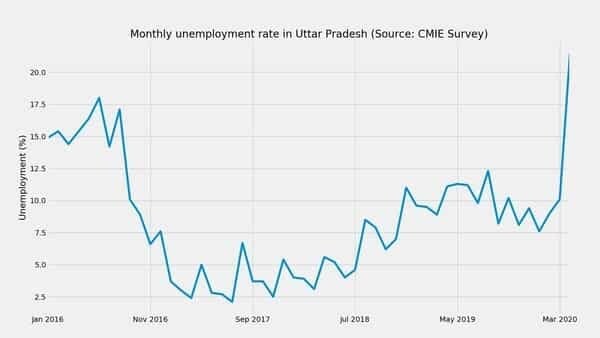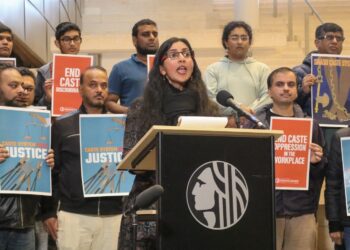With unemployment rate touching a whopping 7.91% last month, India’s educated youth are increasingly turning their backs on their homeland to relocate to countries like Canada in search of employment.
India has been seeing a rapid increase in youths seeking work visas in countries like Canada and Australia recently. The reason is there for everyone to see. Unemployment has become the tipping point for the country’s youth who are unable to find any job in the country, even after completing their hard-earned degrees.
“There are not enough jobs for us here, and whenever government vacancies come up, we hear of cheating, leaking of test papers,” said Srijan Upadhyay, speaking to Reuters. Srijan had a roadside eatery in Bihar which closed down when the pandemic started. The 31-year-old IT undergraduate travelled to Rajpura in Punjab with his neighbour, a commerce graduate, also in search of a job, to meet consultants of a firm that had promised to get him a work visa for Canada.
“I am sure we will get a job in Canada, whatever it is initially,” he said.
Lovepreet, counsellor of one such consultancy, Blue Line, says he is handling about 40 such clients a day and he expects it to grow in the coming months.
“I have been doing this for four years,” he told Reuters. “I am off to Canada myself, this year or next year. Politicians keep promising us government jobs, but no one delivers.”

According to reports, both rural and urban unemployment rates saw an increase from November to December last year. Rural jobless rate was 7.28%, while urban unemployment rate increased to 9.3% in December 2021.
India’s overall joblessness rate peaked at 23.5% in April 2020 and is hovering around 7.9% in December 2021, according to the Centre for Monitoring Indian Economy (CMIE), a Mumbai-based economic think-tank and business database company. The highest unemployment rates were reported in Haryana (34.1%), Rajasthan (24.1), Jharkhand (17.3%), Bihar (16%), and Jammu and Kashmir (15%).
CMIE data shows that India’s unemployment has exceeded the global rate in five of the last six years due to an economic slowdown that was amplified by the pandemic.
Unemployment has been on the decline in other parts of the world though. The rate in Canada fell to a multi-month-low of 5.9% in December, while the OECD group of mostly rich countries reported a sixth straight month of decline in October, with countries including the United States and Germany complaining of labour shortages as their economy picks up.
Whatever little economic growth that India is showing, it is producing fewer jobs than before, with jobseekers ready to take up menial roles or relocate abroad. Also alarming is the fact that India’s rate of workforce participation is declining.
“The situation is worse than what the unemployment rate shows,” CMIE Managing Director Mahesh Vyas told Reuters. “The unemployment rate only measures the proportion who do not find jobs of those who are actively seeking jobs. The problem is the proportion seeking jobs itself is shrinking.”
Hopelessness among India’s youth is now a searing problem for the incumbent government headed by Narendra Modi who had spoken of creating millions of jobs before coming to power. This lack of generation of jobs is being seen as one of his biggest failures. He is also being criticised for wasting India’s demographic advantage of having a working-age population that was more than two-thirds of its 1.35 billion work force.
The labour ministry’s career website shows more than 13 million active jobseekers as of last month, with only 220,000 vacancies.
In the last two days, India has been witnessing protests by thousands of students protesting against the Ministry of Railways’ recruitment process and the brutal retaliation by Uttar Pradesh and Bihar state police forces. These protests for jobs are an indication of the times to come. With elections coming up in five states, including Punjab and a highly populous UP, Opposition parties are trying to drum up voter passions using the falling employment numbers.
“Because of a lack of employment opportunities here, every kid looks at Canada. Parents hope to somehow send their kids to Canada,” Delhi Chief Minister Arvind Kejriwal, whose Aam Admi Party is running for elections in Punjab, told a recent gathering at a function there.
According to figures available on the Ghar Ghar Rozgar website of the Punjab government, there are 12,946 government jobs available in the state (as of 22 January 2022), for more than 1.3 million registered job seekers. The number of available private sector jobs is 10,910, while the total number of registered employers is 12,041.
Some states, like Haryana are trying to reserve jobs for local youths in a bid to discourage discontent among youth. But it remains to be seen if global private companies would be satisfied to select from a limited job-force.
According to CMIE’s Mahesh Vyas, India needs more investment in labour-intensive industries and should bring more women into the labour force, like Bangladesh has done through its garments factories. He feels that India will be able to generate more better-quality jobs only if employment is generated either directly in government or in large private enterprises.
Unemployment is a critical issue in India because every year an average of 12 million people reach working age. But the economy cannot absorb them because it has not grown fast enough.











